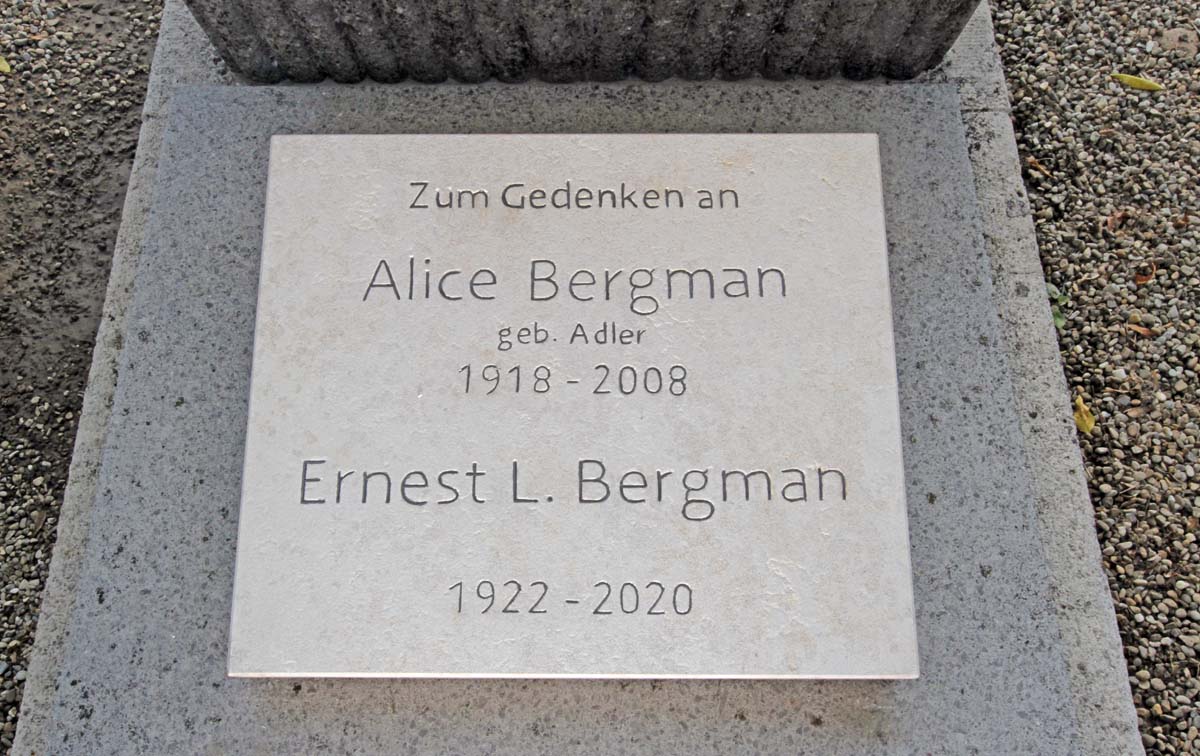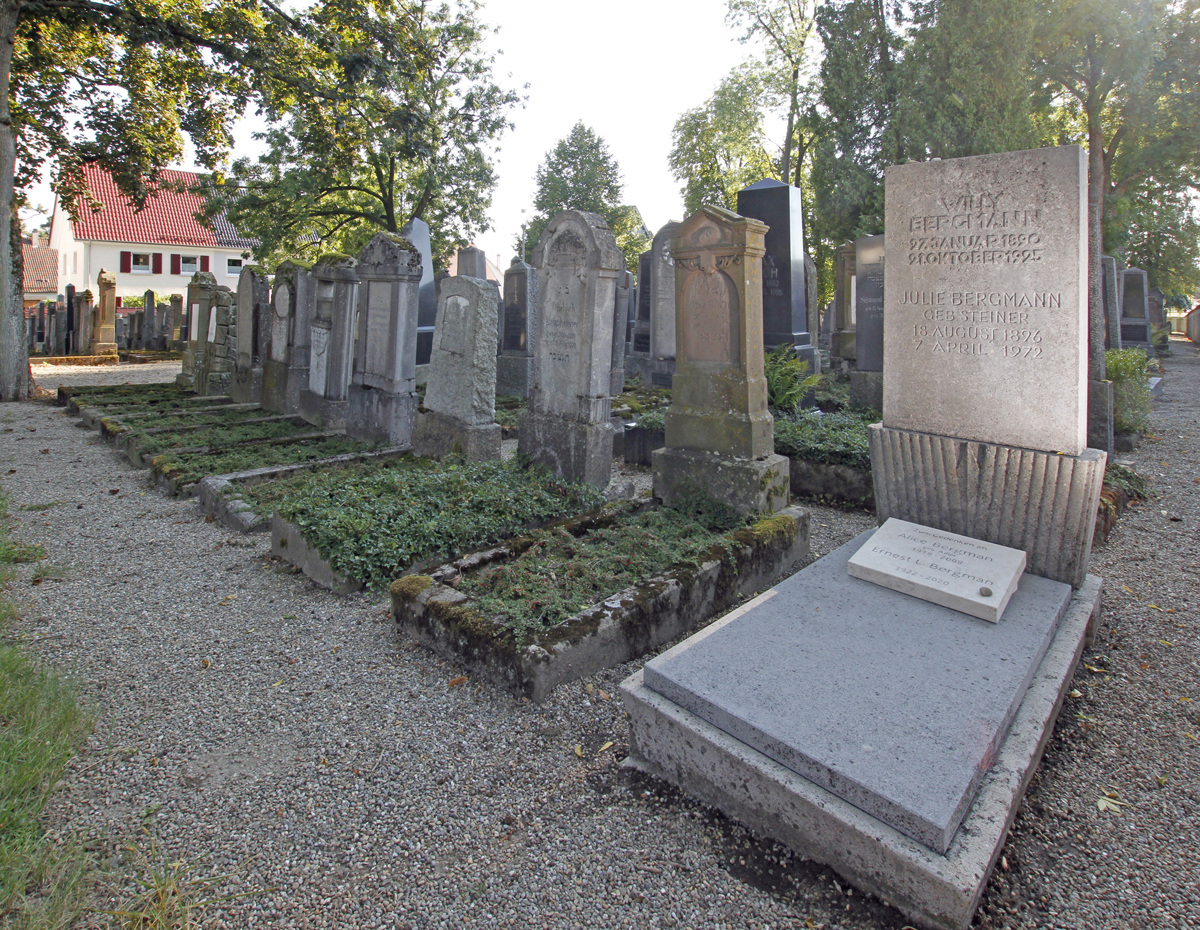
|
|
In Memory of Ernest L. Bergman (Ernst Leopold Bergmann) Honorar member of the "Gesellschaft für Geschichte und Gedenken e.V."
born on July 12, 1922 in Munich, Germany - died on August 15, 2020 in State College PA , USA נצבה״ח |
|
|
Obituary of Ernest L. Bergman
|
Ernest L. Bergman of State College died on Saturday evening. He left the following typewritten text for his obituary. Born July 12, 1922 in Munich, Germany, he was a son of the late Willy J. and Julia Steiner Bergmann.
Here he went to Grade School and completed 3 years of Latin School. Due to the political situation in Germany in 1936, he moved to his uncle and aunt in St. Gallen, Switzerland, where the finished his secondary education. He attended the Kant. Ldw. Schule Schwand Münsingen, Kt. Bern (1939-1941) and received the diploma. He also worked on various farms and at Kant. Gartenbauschule Oeschberg-Koppigen where he received a certificate in vegetable crops and was certified as a fruit growing specialist. In 1946 he left Switzerland with his mother and brother for the USA. Because he was a stateless person at that time he had to travel with a Nansen passport for refugees. During the first winter in the USA he was pruning apple trees in Poughkeepsie, N.Y. In 1947 he moved to Oregon where he worked on his relatives' hops ranch and as a horticulturist on a large berry farm. In January 1946, he came back to New York, N.Y. to meet his fiancée Alice H. Adler, who arrived then from St. Gallen, Switzerland. They were married on February 15, 1948 and went back to Oregon. After receiving his U.S. citizenship in 1952, Ernie started working as an experimental aide at the Horticulture department of the Oregon State Agriculture Experiment Station in Corvallis, OR. In 1953 he was permitted to take courses and graduated in 1955 with the B.S. in Horticulture-Pomology, which included 2 years credit for his Swiss education. From 1955-1958 he worked as a Special Graduate Research Assistant on Concord Grapes at Michigan State University and received his M.S. (1956) and Ph.D. (1958) in Plant Nutrition from the Horticulture Department. Ernie started as Asst. Prof. of Plant Nutrition at the Horticulture Dept. of the Penn State University in 1958 and was promoted to Assoc. Prof. in 1963 and Professor in 1970. He retired as Prof. Emeritus in 1987. During his tenure he served on many Departmental, College, and University Committees (Chair, University Faculty Senate 1974-1975). He was an undergraduate and graduate student advisor (13 Ph.D.) and served on countless M.S. committees. His activities encompassed teaching and research in horticulture crop production, plant nutrition, plant analyses, fertilizer use, and hydroponics crop nutrition. Ernie also had to help the Extension service when necessary and was involved in international agriculture with assignments in Argentina (three times 3 months), Uruguay, the Peoples Republic of China (five times), Senegal, and Mali. He was a member of the Agronomy Society, the International Horticulture Society, Sigma Xi, and Alpha Zeta, and attended with his wife many national and international meetings. Ernie was elected Fellow of AAAS and the American Soc. for Hort. Sciences, where he served on the board as vice-president for international affairs and on many committees. He was President and also received "Man of the Year Award" from the PA Plant Food & Protectant Education Soc. in 1983 and Hon. Life Membership of the PA Veg. Growers Assoc. in 1987. Ernie was a 40+ year State College Kiwanis Club member (distinguished past president, Hixson Fellow, District Lt. Governor, District IDD chairman); Life member of Mt. Nittany Philatelic Society; Hon. Life member American Helvetia Philatelic Soc. (past president); Life member ofthe American Philatelic Society (Board member), and American Philatelic Library (Trustee). He was an initial member of Congregation Brit Shalom of State College, PA. At one time Ernie pledged, if he ever again became a citizen he would serve his country, a pledge he fulfilled by his civic activities during 43 years in the Centre region. He was 10 years elected Ferguson township supervisor, served in many appointed positions in township, Centre Region Council of Government (chairman), Spring Creek Watershed Commission, and Centre County Planning Commission. He was past chairman and 25-year board member each of Patton Ferguson Joint (also cofounder) and University Area Joint Authorities. He also was a board member (13 years) of the Centre Life-Link EMS, Penn State Retired Faculty Staff Club (past president), and initial member of the Penn State Federal Credit Union (also past president). Ernie was honored by Ferguson township in naming a street "Bergman Court" and in 2003 by citations of both the House of Representatives and senate of the Commonwealth of Pennsylvania. He is survived by his sister-in-law Eva Bergmann of Silver Spring, MD, his nieces Catherine Bergmann and family, Riverdale, MD, and Sandra Bergmann and husband of Kamuela, HI, his late wife's niece Judy Taylor, of Witney, England, and nephew Dr. Eric Haywood, Dublin, Ireland. In addition to his parents and his brother Willy Bergmann, he was predeceased by his wife of 60 years, Alice H. Bergman who passed away in May 2008. Arrangements are under the care of Koch Funeral Home, State College. Online condolences and signing of the guest book may be entered at www.kochfuneralhome.com. |
 Ernest L. Bergmann 2012 in the Homeoffice. 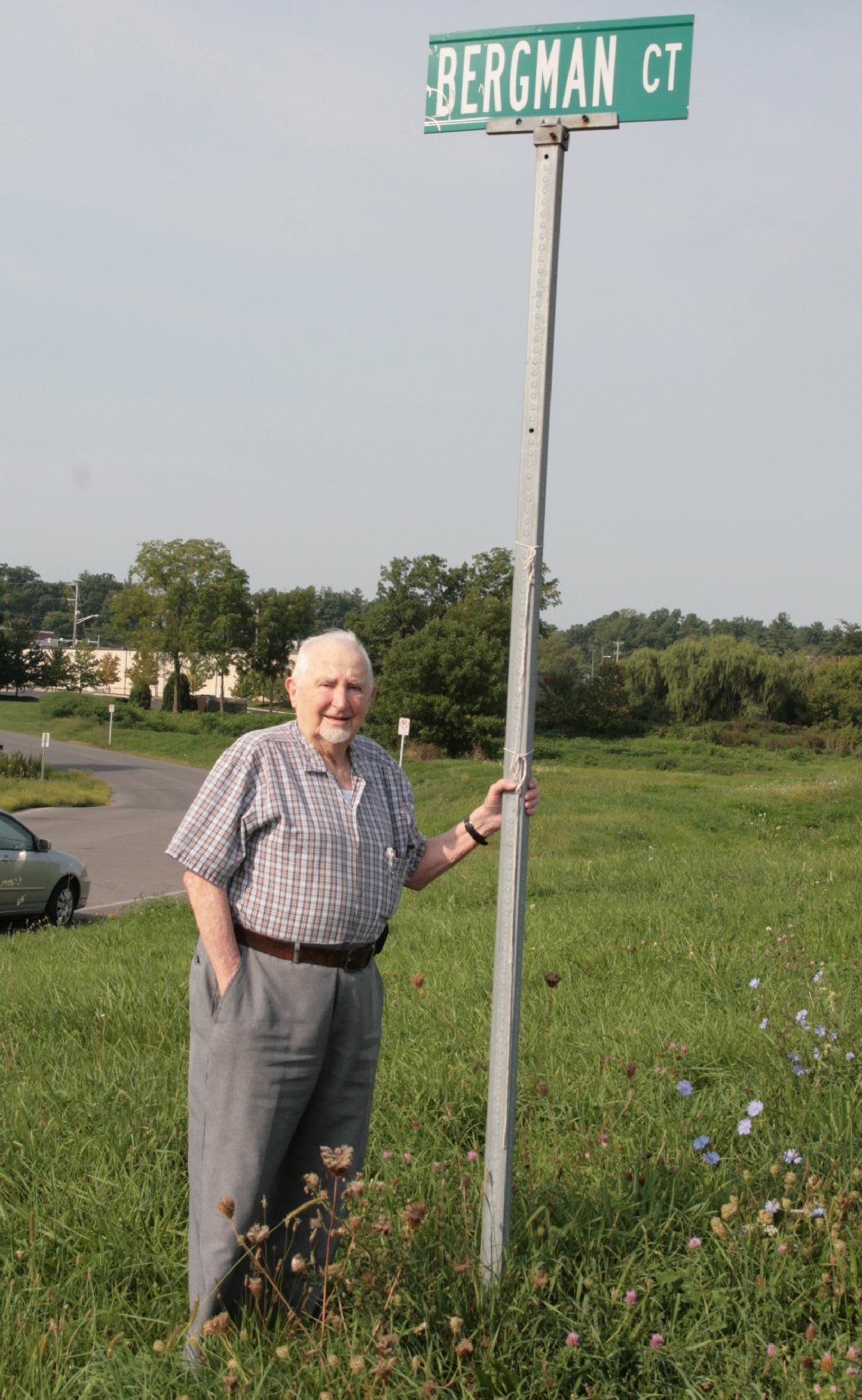 In 2003 are Ernest Bergmann eine Straße in State College benannt. |
Obituary in the Laupheim News "Schwäbische Zeitung"
|
Text from the Schwäbische Zeitung from August 20, 2020 by Barbara Braig Sad news from America:
At the age
of 98, Ernest Bergman passed away peacefully last Saturday in State
College, Pennsylvania, in the presence of his niece Catherine Bergmann.
Ernest Bergman was born Ernst Bergmann on July 12, 1922 in Munich and
moved to Laupheim with his mother and brother in 1925 after the death of
his father. In 1936, when the political pressure from the Nazi regime
increased, the then 14-year-old of Jewish faith fled to his uncle in
Switzerland and in 1946 emigrated to the USA. It was not until the late
1950s that Bergman made contact with his former home in Laupheim - he
submitted an application to the Reparation Office of the City of
Laupheim to support his studies in the USA. He was now an American
citizen and had changed his name slightly. His childhood friend Sixt
Brecht worked at the office at the time, who immediately contacted
Ernest Bergman and invited him to Germany. From 1958 until after the
turn of the millennium, Ernest Bergman visited his friend Sixt Brecht in
Laupheim every year. An illness and the death of his wife interrupted
the visits for several years. Bergman did not travel to Laupheim again
until 2009 - for the premiere of "Berlin 36", the film about the fate of
the high jumper Gretel Bergmann, with whom he was also related - her
grandfathers were brothers. As a professor of agricultural sciences, he
was highly regarded in his adopted country of America. In Laupheim he
was made an honorary member of the Society for History and Commemoration
(GGG). Michael Schick, second chairman of the GGG, was in constant
contact with Ernest Bergman until a few years ago. “He was always
interested in what was happening in Laupheim. With his youthful, open
manner, I was always welcome in Laupheim. ”Schick - together with his
family - visited Ernest Bergman in America in 2012:“ He was really happy
to welcome someone from his old home there. ”In his room at The walls of
the retirement home were full of pictures from Laupheim - the city that
he always had in his heart. |
Ernst Bergmann and Laupheim
|
From the Book The Jewish Community of Laupheim and its Annihilation to BERGMANN, Julie, née. Steiner, with quotes from Ernest Bergman “My grandfather always had two horses for use at the tannery. Then we had also six cows and about 25 acres of land. By that time I already took great interest in agriculture, and ran around the courtyard with the young cattle. Later on I even was called “the young Jewish farmer from the Grund (area near the Schlosspark)”. I often helped with all the work in the fields. Once they let me drive two hay wagons , but - alas! - at the great Jahn oak tree at the end of the Kapellenstrasse the two oxen, which we had at that time, wanted to turn into the Ulmer Strasse because there we used to get the grass for the cows in the mornings. A nice man helped me then to redirect my team of oxen, and I arrived safely, with some delay, in the Vorholz meadows. But this was the end of my driving. The nicest thing with the hay and wheat harvest were the picnics during the breaks, and I loved to go to the several butchers in town to buy the necessary products. In summer we used to ride to the “Bastel” forest to check the state of the bark needed for the tannery. This I really enjoyed, in particular the “visits” to the pubs. I also admired the blossoming of the wonderful wild lupins. Frequently we cycled to go swimming at some of the nearby mills or even at Stetten or Mönchhöfe. But there I was afraid of the water rats.” "We were more and more like Germans. For instance at Easter, the Jewish Passah holiday, there is a prayer which says: ‘Next year in Jerusalem !’ – but my grandfather whispered every year: ‘We don’t say that, we are Germans!’ This, in spite of his presiding over the Jewish congregation and all the family life observing Jewish customs. But this changed quickly in 1933 when Hitler grasped power and the political climate in Germany turned entirely. On April 1, 1933 people of the SA appeared in front of the Jewish shops with signs requesting the population to boycott them. There was one as well in front of the tannery.” In April 1933 Ernst Bergmann was able to move to a secondary school which offered Latin as a foreign language. At this time this was still possible with special permission: children of First World War participants were still granted the possibility of attending higher schools. He cannot remember teachers or students with anti-Semitic attitudes. Out of the 13 pupils of his class who came from all the Laupheim elementary schools – the Catholic, the Protestant and the Jewish all together, there were 3 Jews: Ruth Friedland, Heinz Bach, and he himself: “That was the first time we met together. And we had difficulties in understanding one another. But with regard to my class, they all were very decent. But that somebody in the class should beat someone up – that never happened to me.” "At the first Reich Sports Festival we were permitted to take part, and I even got a certificate signed by the minister Baldur von Schirach. But the next year Jews were excluded from participating. I also had to resign from the Laupheim Sports Club, and on my way home from gymnastics was the victim of verbal abuse. I joined the sports group of the Reich Association of Jewish Soldiers who did sports and played handball on the public “Luss” green every Sunday morning. Then the Nuremberg laws came into effect and all women employees had to leave, which hurt us very much. The actions against the Jewish shops were supported also actively by Austrian “legionaries” who were in a camp in Burgrieden. They damaged the shops by throwing stones into the windows, and even tried to set fire to the (Jewish) Restaurant “Ochsen”. As well during the Feast of Tabernacles in 1935 we were bombarded by stones in the garden of the Jewish community center, but no one got hurt.”
|
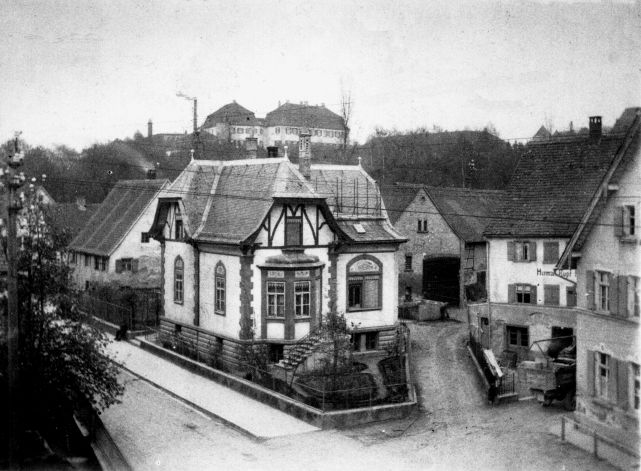
1922 Bronner Street 22 with Castle of Gross-Laupheim, entrance to the stables and barn, and the house of H. Rupf and the butcher`s “Wyse”. From 1925 stay Ernst Bergmann with his Brother Willi and the Mother Mutter Julie in Laupheim by the grandparents Melanie and Simon Leopold Steiner.
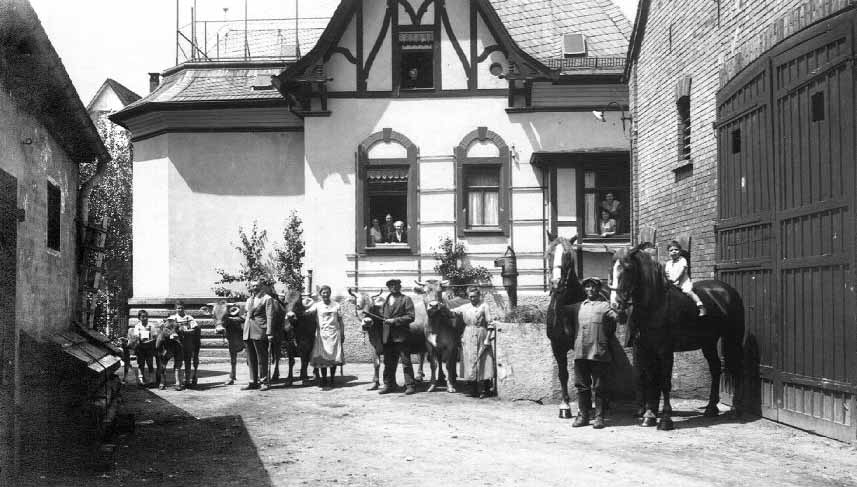
The 70th birthday of Grandpa (Simon Steiner) on June 18, 1934. All the cattle were shown on the photo.
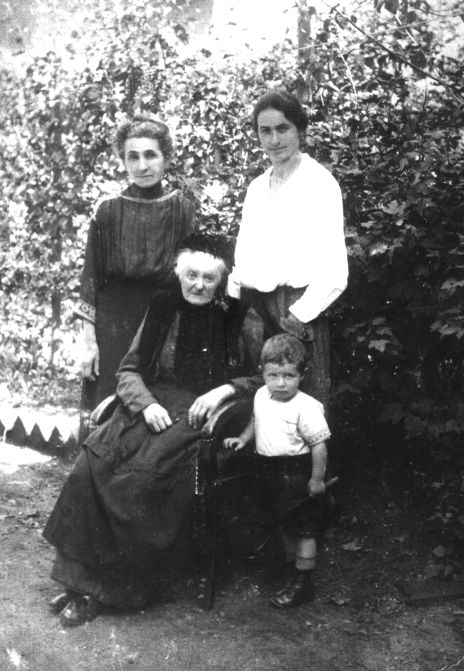 Four generations in one picture (1924). Seated: great-grandmother Fanny Steiner, née Rosengart. After her passing away the family founded the Fanny-Steiner-Trust to support youth during their vocational training. On the left grandmother Melanie Steiner, née Herz. On the right Julie and Ernst Bergmann. |
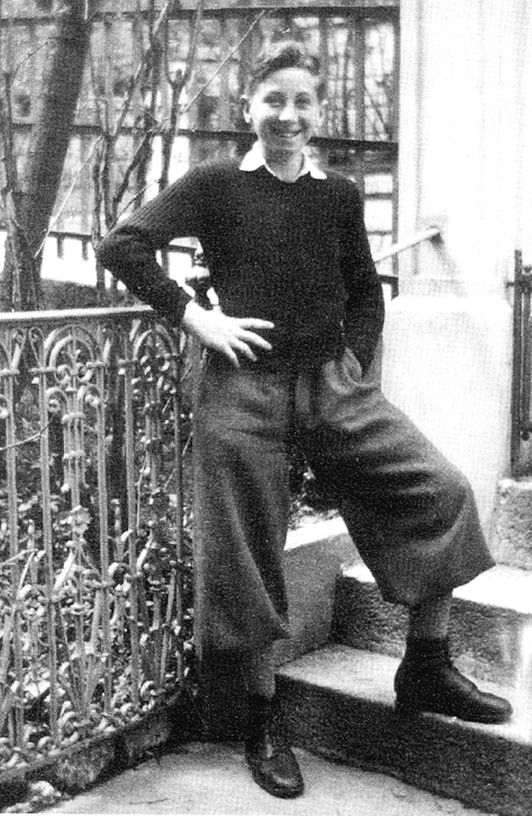 Ernst Bergmann in Zwingli Street in St. Gallen/Swizerland 1938. |
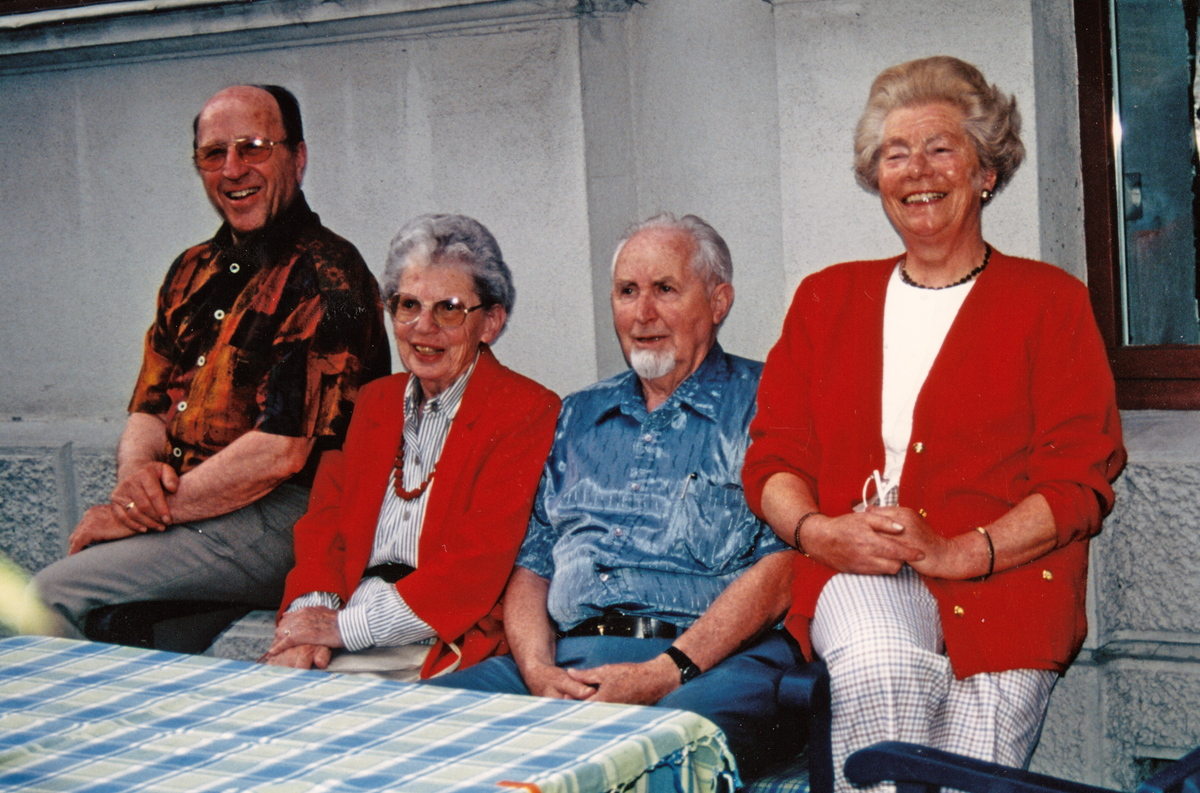
Ernest and Alice Bergman in 1998 by a visit in Laupheim. Left and right the host: Sixt and Friedelinde Brecht.
Pictures from a visit in Laupheim 2009.
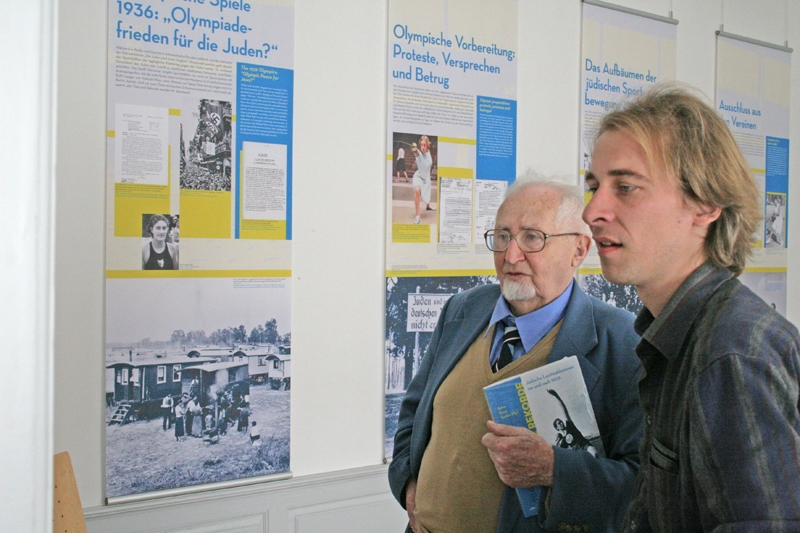 Visiting the Museum zur Geschichte von Christen und Juden with Dr. Michael Niemetz |
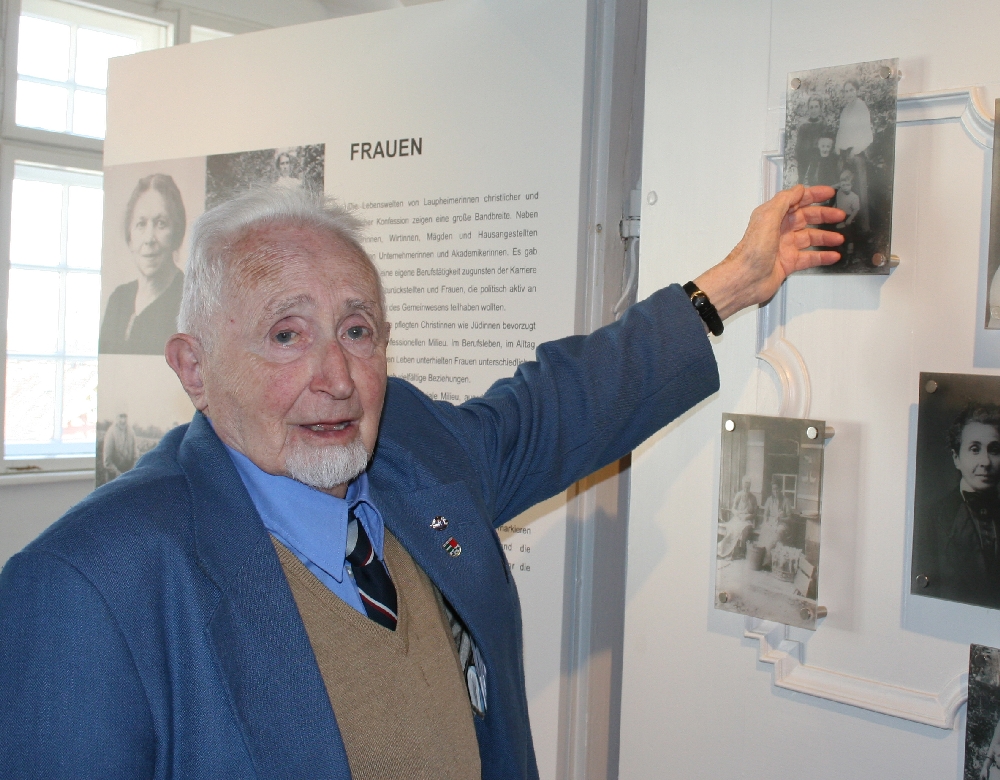 In the Museum zur Geschichte von Christen und Juden |
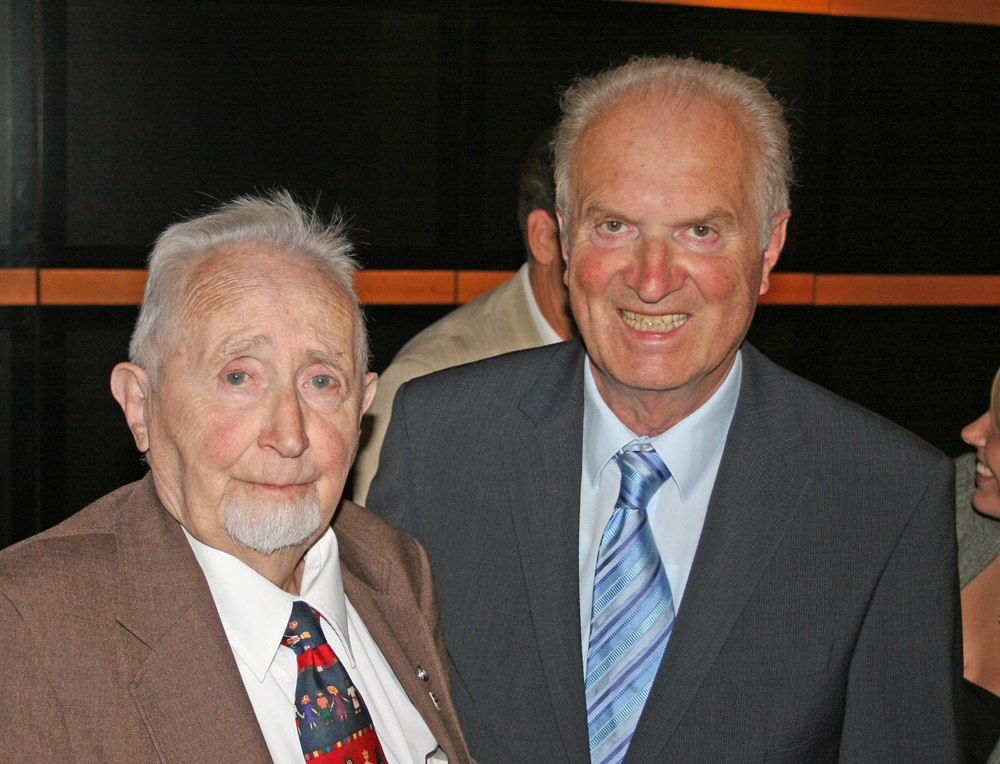 Ernest Bergman and Laupheim’s former mayor Otmar Schick |
|
At the film premiere of “BERLIN 36 |
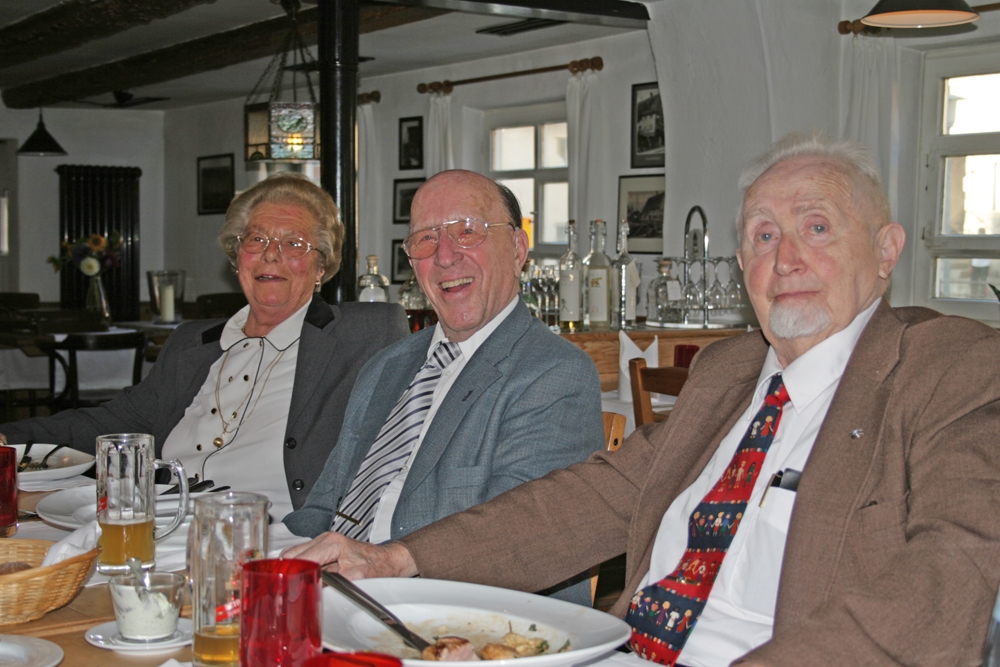 Ernest Bergman with his childhood friend Sixt Brecht and his wife |
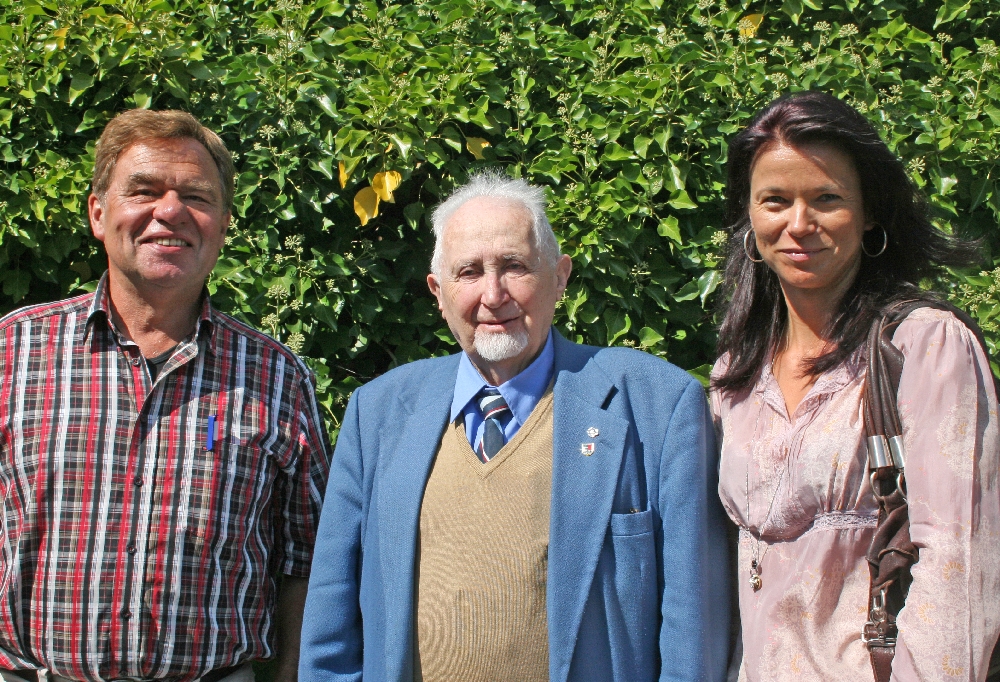 Ernest Bergman, co-author of the memory book about the Jewish community in Laupheim, together with Karl Neidlinger and Dr. Antje Köhlerschmitt |
|
Friedelinde Brecht welcomes Ernest Bergman |
Press talk after the premiere of "BERLIN 36" |
Ernest Bergman, honorary guest of the Society for History and Commemoration, together with Elisabeth Lincke . |
|
"Old friends" Ernest Bergman and Berta Halder shortly after her 90. birthday |
In Berta Halder’s living room |
Coffee break: Ernest Bergman, Mr. and Ms. Brecht invited by the Schick family |
|
Visiting the Jewish cemetery |
Ernest Bergman at the grave of his parents Julie und Willi Bergmann |
Old friends: Ernest Bergman visiting his long-time friend Ernst Schäll |
"Memories"
|
During a visit at Professor Dr. Ernest Bergmann in State College / Pennsylvania In 2012 the Schick family visited New York and made a trip to State College from Aug. 31 to Sept. 1: The longest and most impressing excursion during our stay in the United States was when we visited the ninety-year old Professor Dr. Ernest Bergmann in State College. On Friday, 31st of August we rented a car in New York for two days and started heading west. Equipped with GPS we managed our way through the New York city traffic and continued with a 4-hour ride on the highway to State College, Pennsylvania. State College is a known college town dominated by the Pennsylvania State University with a total of 80.000 students, thereof 41.000 in the central municipality. This is where Professor Bergmann has spent his life for about 54 years. He was a teacher at the university and also engaged in communal politics, being a mayor in his municipality for several years. State College owes him a lot, they even named a street after him, which you can see on the picture! In his apartment you can also see many awards from the university, several associations and State College municipalities. Mr. Bergmann was very excited about our visit because in 54 years Jahren there was only one visit from abroad before. Accordingly, it was a great honor for us having the opportunity to visit him. Yet, we picked the wrong time: there was an important football match against Ohio, the local stadium completely sold out with almost 108.000 attendees, and… State College lost! Anyway, Mr. Bergmann took the opportunity to guide us through the city during the match and it looked as if it was deserted. For a couple of years, after his wife passed away, he’s living in a retirement home that is quite unusual to our standards: It is characterized by coziness and human affection, and you could never feel any kind of sterile hospital atmosphere, which is rather characteristic for many old people’s homes in Germany. Visitors are astonished by nice paintings on the wall, thick carpets, elegant wallpapers and old English-style furniture. Several hundred people live here on two floors across various connected buildings. The outdoor area is properly maintained, and flowers are blooming everywhere. Mr. Bergmann’s apartment is full of memories of his old home and awards from his professional life. We enjoyed the time with him very much and we listened carefully to his stories from old times. He was very thankful for the museum guide and the chocolates from Laupheim and asked us to send his regards to all who know him! On Sunday, we had to leave early because we had to hand over the rental car in New York by 10am. Mr. Bergman, a big thank you for your warm hospitality!
|
Vlasta, Julia and Michael Schick visiting State College 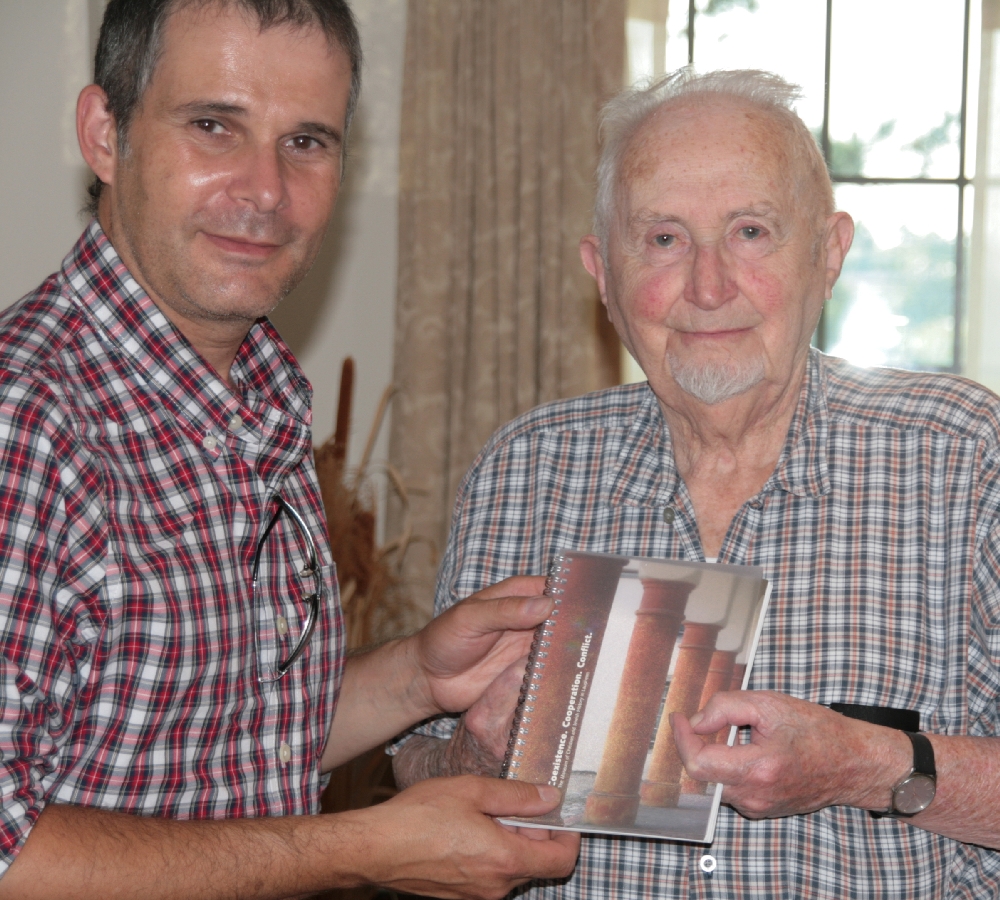
|
